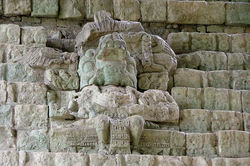
Copán Ruins
The Copán Ruins are the ruins of an ancient Mayan city. It was discovered in 1570 but not excavated until the 19th century. It is the political and cultural center of Copán Valley and lies in the mountainous region of western Honduras. The site began as a small agricultural village in 1000 BCE and at its peak in the 9th century, it contained around 20,000 people. A dynasty of at least 16 Mayan kings had ruled there. However, the site was completely abandoned in 1200. The ruins are comprised of 250 acres. It includes a main complex with secondary complexes surrounding it. The main complex consists of the Acropolis and important plazas. Among the five plazas are the Ceremonial Plaza, with an impressive stadium opening onto a mound with numerous richly sculptured monoliths and altars; the Hieroglyphic Stairway Plaza, with a monumental stairway at its eastern end that is one of the outstanding structures of Mayan culture. On the risers of this 100 m wide stairway are more than 1,800 individual glyphs which constitute the longest known Mayan inscription. The site was declared a UNESCO World Heritage Site in 1980 and has contributed to much of our understanding of Mayan history and culture.
 |  |  |  |
|---|


